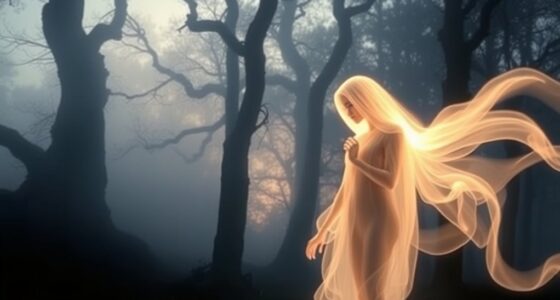Ghost hunting started in the 19th century with séances, where people used mediums to try and communicate with spirits. Over time, curiosity shifted toward scientific investigation, incorporating basic tools like cameras and audio recorders. In the late 20th century, electromagnetic field (EMF) meters and other advanced equipment became common, transforming ghost hunting into a more evidence-based pursuit. If you’re curious how these innovations continue to shape paranormal research, there’s more to explore ahead.
Key Takeaways
- Ghost hunting originated from 19th-century séances aimed at communicating with spirits using mediums.
- It shifted from superstition to scientific inquiry with early tools like cameras and audio recorders.
- Technological advancements introduced EMF meters in the late 20th century to detect electromagnetic fluctuations.
- Modern ghost hunting incorporates digital cameras, infrared vision, spirit boxes, and standardized investigation protocols.
- The field has evolved from spiritualist séances to evidence-based research through continuous technological innovation.

Have you ever wondered how ghost hunting began? It’s a fascinating journey that traces back to early paranormal investigations, where curiosity about spirits and the afterlife prompted people to seek answers beyond the physical domain. In the 19th century, séances became popular as a way to communicate with the dead. Participants would gather in dimly lit rooms, attempting to summon spirits through mediums. These gatherings laid the groundwork for modern ghost hunting, blending spiritualism with a desire to uncover the unseen. Over time, enthusiasts started to adopt a more systematic approach, moving from superstition to scientific inquiry. This shift marked the start of ghost hunting as a form of paranormal investigation, driven by a mix of curiosity and skepticism.
As technology advanced, so did the methods used in these investigations. Early ghost hunters relied on basic tools like flashlights, cameras, and audio recorders to capture unexplained phenomena. The introduction of electromagnetic field (EMF) meters in the late 20th century was a major milestone. These devices aimed to detect fluctuations in electromagnetic energy—an idea rooted in the belief that spirits could influence electromagnetic fields in the environment. The adoption of EMF meters and other technological tools transformed ghost hunting from mere observation into a more disciplined pursuit, giving investigators tangible data to analyze. These technological advancements allowed enthusiasts to document seemingly paranormal activity with greater clarity, moving beyond subjective experiences and personal impressions.
Throughout the years, innovations in technology have continually shaped how people approach ghost hunting. Digital cameras, infrared night vision, and audio recorders equipped with noise reduction became standard equipment for investigators. These tools helped capture EVP (Electronic Voice Phenomena) and visual anomalies, providing evidence that could be analyzed objectively. The field also grew more collaborative, with investigators sharing findings and developing standardized protocols. Today, the use of specialized equipment like thermal imaging cameras and even spirit boxes reflects how far paranormal investigations have come—from spiritualist séances to highly technological pursuits. Moreover, the shift from superstition to scientific inquiry has been heavily influenced by advancements in paranormal investigation tools and methods.
In the end, the history of ghost hunting is a story of evolving curiosity, scientific curiosity, and technological progress. Each new advancement has pushed the boundaries of what’s possible, turning a once mystical practice into a more structured and evidence-based exploration. From the early days of spiritualism to today’s high-tech investigations, you can see how each era built upon the last, constantly refining the quest to understand the unknown.
Frequently Asked Questions
What Are the Most Common Tools Used in Modern Ghost Hunting?
You’ll find modern ghost hunters often use tools like EMF meters, digital voice recorders, and infrared cameras to detect paranormal activity. These tools help validate spiritual rituals and explore historical ghost tales. You might also use spirit boxes or thermal imaging devices. By combining technology with intuition, you get a more all-encompassing approach to uncovering spirits, making your investigations more credible and exciting.
How Do Ghost Hunters Differentiate Real Evidence From Hoaxes?
Think of ghost hunters as detectives unraveling a mystery—your goal is to separate fact from fiction. You perform evidence validation by analyzing data from EMF meters, EVP recordings, and thermal cameras. To spot hoaxes, you look for inconsistencies, verify sources, and use multiple tools to cross-check results. This meticulous process helps guarantee you catch genuine paranormal activity while confidently dismissing hoaxes that try to mimic real evidence.
Are There Any Legal Restrictions on Ghost Hunting Activities?
You should know that legal restrictions on ghost hunting vary by location. Many areas require you to respect property rights, meaning you often need permission before exploring private sites. Trespassing laws can lead to fines or arrest if disregarded. Always research local regulations beforehand, and seek permission from property owners to avoid legal trouble. Staying informed about property rights and restrictions helps ensure your ghost hunting activities stay within the law.
What Psychological Effects Can Ghost Hunting Have on Participants?
Ghost hunting can cause psychological stress, especially if you encounter frightening experiences or feel unsafe. It also impacts group dynamics, as shared fears or excitement may intensify emotions and influence behavior. You might find yourself anxious or paranoid afterward, questioning reality. Be aware that these activities can have lasting effects on your mental health, so stay cautious, communicate openly with your group, and take breaks to manage stress effectively.
How Has Technology Advanced Ghost Detection Methods Over Time?
You see, technological innovations have revolutionized ghost detection, making it more scientific and precise. Historical methods relied on séances and intuition, but now, you use EMF meters, infrared cameras, and digital recorders to gather evidence. These tools help you detect electromagnetic fluctuations or unexplained sounds, increasing accuracy. Over time, these advancements have transformed ghost hunting from superstition into a more systematic practice, allowing you to investigate paranormal phenomena with greater confidence.
Conclusion
As you can see, ghost hunting has evolved from spiritual séances to high-tech EMF meters, reflecting society’s changing beliefs and tools. While methods have advanced, the core fascination remains the same. Remember, don’t judge a book by its cover—sometimes, the simplest methods can be the most revealing. Whether you’re a skeptic or a believer, exploring this history shows that the quest to understand the unknown is a journey worth taking. Keep an open mind and stay curious.









